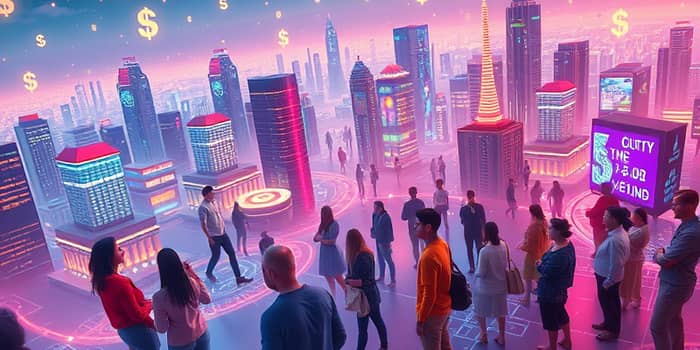
The digital world is no longer a playground; it has become a thriving financial ecosystem where capital flows, assets are tokenized, and services are reinvented. As of 2025, the global metaverse market cap has soared beyond $552 billion, and the finance sector within it stands at $76 billion with a projected growth of $876.2 billion by 2029. These figures underscore the substantial real-world financial opportunities emerging in virtual realms.
From blockchain-secured marketplaces to interoperable identity systems, virtual economies mirror—and sometimes outpace—their physical counterparts. Over 70 million users now transact financially in metaverse platforms, and stablecoins represent roughly 65% of all commerce, ensuring price stability and cross-border access.
Unique digital assets—virtual real estate, collectibles, in-game items, digital artwork, and avatar apparel—are traded, staked, and leveraged across platforms. The tokenized asset market cap has reached $312 billion, reflecting broad adoption of persistent, real-time economies that operate even when users are offline.
Decentralized finance (DeFi) is embedded at the heart of metaverse activity, enabling users to borrow, lend, stake, and trade with unprecedented autonomy. As of mid-2025, more than 160 active financial dApps support NFT-backed loans at an average APR of 9.4%, yield farming, fractional ownership, and cross-chain liquidity.
The total DeFi lending market in the metaverse surpasses $48 billion, with major protocols like Aave capturing 45% of that value (TVL of $25.41 billion). Tokenization also extends to real-world assets—property, fine art, portfolios—allowing fractional participation in high-value holdings.
Virtual land has become a cornerstone investment in platforms such as Decentraland and The Sandbox. Digital parcels can be bought, sold, rented, and developed into venues, shops, or event spaces, generating revenue through ticketed experiences, retail sales, and advertising.
These marketplaces reflect real-world dynamics—mortgages, speculation, rental agreements—while offering lower entry costs and global participation via cross-platform liquidity environment innovations.
Traditional finance is staking its claim within the metaverse. Virtual banks now issue loans against digital assets, facilitate stablecoin payrolls, and underwrite insurance for avatars and virtual properties. DeFi-based insurance is growing at a 31.5% year-over-year rate, offering micro-insurance and decentralized coverage against hacks or asset loss.
Over 19 million “virtual economy workers” receive crypto-based payrolls, and established banks and fintechs are launching metaverse divisions to capture this burgeoning demand. This fusion of on-chain services with legacy systems promises fractionalized ownership models and programmable financial products tailored to virtual environments.
The metaverse is generating entirely new career paths and entrepreneurial ventures. From digital architects designing immersive experiences to DeFi engineers building next-gen protocols, virtual economies have lowered barriers for innovators worldwide.
Millions of users now earn a living through virtual services and content creation, highlighting the lower barriers to global access that define metaverse entrepreneurship.
Advances in VR/AR hardware power immersive financial hubs—from virtual trading floors to interactive banking lobbies. Layer-2 solutions reduce transaction costs by up to 87%, while interoperability protocols enable seamless transfers of tokens and NFTs between different virtual worlds and DeFi ecosystems.
As blockchain networks scale and compute power grows, immersive experiences will integrate real-time data, AI-driven analytics, and programmable money, fostering an environment where financial innovation and user experience coalesce.
With a metaverse economy projected to reach $1.2 trillion by 2030—and finance comprising nearly 15% of that value—regulators are paying close attention. Compliance frameworks for digital assets, anti-money laundering rules, and consumer protections are under development globally.
Decentralized autonomous organizations (DAOs) are emerging as key governance structures, while public companies with dedicated metaverse units report 22% year-over-year stock growth. Financial inclusion in emerging markets, especially in APAC, stands to benefit as virtual finance reduces traditional barriers.
The convergence of the metaverse and finance is not a distant vision—it is unfolding now. From tokenization and DeFi to virtual real estate and immersive banking, users and institutions alike are discovering embedded DeFi services that redefine value and ownership.
As infrastructure matures, regulatory clarity emerges, and global participation expands, the metaverse offers a unique opportunity to build more inclusive, transparent, and innovative financial systems. Stakeholders who embrace these dynamics today will shape the next era of economic growth in both virtual and physical worlds.
References





